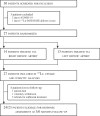Intra-arterial peptide-receptor radionuclide therapy for neuro-endocrine tumour liver metastases: an in-patient randomised controlled trial (LUTIA)
- PMID: 37897617
- PMCID: PMC10881701
- DOI: 10.1007/s00259-023-06467-y
Intra-arterial peptide-receptor radionuclide therapy for neuro-endocrine tumour liver metastases: an in-patient randomised controlled trial (LUTIA)
Abstract
Purpose: Peptide receptor radionuclide therapy (PRRT) using [177Lu]Lu-DOTATATE has been shown to effectively prolong progression free survival in grade 1-2 gastroenteropancreatic neuroendocrine tumours (GEP-NET), but is less efficacious in patients with extensive liver metastases. The aim was to investigate whether tumour uptake in liver metastases can be enhanced by intra-arterial administration of [177Lu]Lu-DOTATATE into the hepatic artery, in order to improve tumour response without increasing toxicity.
Methods: Twenty-seven patients with grade 1-2 GEP-NET, and bi-lobar liver metastases were randomized to receive intra-arterial PRRT in the left or right liver lobe for four consecutive cycles. The contralateral liver lobe and extrahepatic disease were treated via a "second-pass" effect and the contralateral lobe was used as the control lobe. Up to three metastases (> 3 cm) per liver lobe were identified as target lesions at baseline on contrast-enhanced CT. The primary endpoint was the tumour-to-non-tumour (T/N) uptake ratio on the 24 h post-treatment [177Lu]Lu-SPECT/CT after the first cycle. This was calculated for each target lesion in both lobes using the mean uptake. T/N ratios in both lobes were compared using paired-samples t-test.
Findings: After the first cycle, a non-significant difference in T/N uptake ratio was observed: T/NIA = 17·4 vs. T/Ncontrol = 16·2 (p = 0·299). The mean increase in T/N was 17% (1·17; 95% CI [1·00; 1·37]). Of all patients, 67% (18/27) showed any increase in T/N ratio after the first cycle.
Conclusion: Intra-arterial [177Lu]Lu-DOTATATE is safe, but does not lead to a clinically significant increase in tumour uptake.
Keywords: Efficacy; Intra-arterial; Neuroendocrine tumour; PRRT; Safety.
© 2023. The Author(s).
Conflict of interest statement
The authors declare no competing interests.
Figures






Similar articles
-
Intra-arterial versus standard intravenous administration of lutetium-177-DOTA-octreotate in patients with NET liver metastases: study protocol for a multicenter, randomized controlled trial (LUTIA trial).Trials. 2020 Feb 5;21(1):141. doi: 10.1186/s13063-019-3888-0. Trials. 2020. PMID: 32024533 Free PMC article.
-
Additional holmium-166 radioembolisation after lutetium-177-dotatate in patients with neuroendocrine tumour liver metastases (HEPAR PLuS): a single-centre, single-arm, open-label, phase 2 study.Lancet Oncol. 2020 Apr;21(4):561-570. doi: 10.1016/S1470-2045(20)30027-9. Epub 2020 Feb 26. Lancet Oncol. 2020. PMID: 32112737 Clinical Trial.
-
Dosimetric analyses of intra-arterial versus standard intravenous administration of 177Lu-DOTATATE in patients of well differentiated neuroendocrine tumor with liver-dominant metastatic disease.Br J Radiol. 2021 Oct 1;94(1126):20210403. doi: 10.1259/bjr.20210403. Epub 2021 Aug 6. Br J Radiol. 2021. PMID: 34357794 Free PMC article.
-
Lutetium-labelled peptides for therapy of neuroendocrine tumours.Eur J Nucl Med Mol Imaging. 2012 Feb;39 Suppl 1(Suppl 1):S103-12. doi: 10.1007/s00259-011-2039-y. Eur J Nucl Med Mol Imaging. 2012. PMID: 22388631 Free PMC article. Review.
-
The evolution of PRRT for the treatment of neuroendocrine tumors; What comes next?Front Endocrinol (Lausanne). 2022 Oct 31;13:941832. doi: 10.3389/fendo.2022.941832. eCollection 2022. Front Endocrinol (Lausanne). 2022. PMID: 36387893 Free PMC article. Review.
Cited by
-
Predictive and prognostic nomogram models for liver metastasis in colorectal neuroendocrine neoplasms: a large population study.Front Endocrinol (Lausanne). 2025 Jan 7;15:1488733. doi: 10.3389/fendo.2024.1488733. eCollection 2024. Front Endocrinol (Lausanne). 2025. PMID: 39839478 Free PMC article.
-
The LUTIA trial: a small step for PRRT, a giant leap for intra-arterial radionuclide therapy trial methodology.Eur J Nucl Med Mol Imaging. 2024 Mar;51(4):1133-1135. doi: 10.1007/s00259-023-06581-x. Eur J Nucl Med Mol Imaging. 2024. PMID: 38158435 No abstract available.
-
Long axial field-of-view PET imaging of intraarterial 2-[18F]FDG injection.Eur J Nucl Med Mol Imaging. 2025 Feb;52(3):1228-1229. doi: 10.1007/s00259-024-06898-1. Epub 2024 Sep 12. Eur J Nucl Med Mol Imaging. 2025. PMID: 39261333 Free PMC article. No abstract available.
-
Current status of peptide receptor radionuclide therapy in grade 1 and 2 gastroenteropancreatic neuroendocrine tumours.J Neuroendocrinol. 2025 Mar;37(3):e13469. doi: 10.1111/jne.13469. Epub 2024 Nov 20. J Neuroendocrinol. 2025. PMID: 39563515 Free PMC article. Review.
-
Liver-Directed Locoregional Therapies for Neuroendocrine Liver Metastases: Recent Advances and Management.Curr Oncol. 2024 Apr 5;31(4):2076-2091. doi: 10.3390/curroncol31040154. Curr Oncol. 2024. PMID: 38668057 Free PMC article. Review.
References
-
- Niederle MB, Hackl M, Kaserer K, Niederle B. Gastroenteropancreatic neuroendocrine tumours: the current incidence and staging based on the WHO and European Neuroendocrine Tumour Society classification: an analysis based on prospectively collected parameters. Endocr Relat Cancer. 2010;17:909–918. doi: 10.1677/ERC-10-0152. - DOI - PubMed
-
- Lesén E, Granfeldt D, Berthon A, Dinet J, Houchard A, Myrenfors P, et al. Treatment patterns and survival among patients with metastatic gastroenteropancreatic neuroendocrine tumours in Sweden-a population-based register-linkage and medical chart review study. J Cancer. 2019;10:6876–6887. doi: 10.7150/jca.32381. - DOI - PMC - PubMed
Publication types
MeSH terms
Substances
LinkOut - more resources
Full Text Sources
Medical
Miscellaneous

